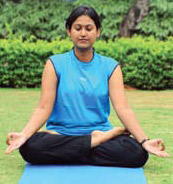Health Topics
-
Healthy Living
-
|
|
August 2009
|
| Yoga and Naturopathy for Hypertension |
| Dr Sreedhar Pulipati |
| |
 |
"Hypertension or increased blood pressure is a staggering health problem today. It has become very common and about 20 percent of adults all over the world suffer with hypertension without even knowing, as it remains asymptomatic until late in its course. Hence it is called a silent killer. |
Its effects when unattended are devastating, affecting every system of the body, and could be fatal. 50 years ago, hypertension or high blood pressure was a relatively uncommon condition.Today, it has become more than just a chronic complaint. It has become a disease of the affluent and middle class population. It still poses a challenge for the medical world for its dependency on continuous medication, and is the most common risk factor for heart attacks."
Blood Pressure and Hypertension
The force with which the heart pumps blood through arteries to reach various parts of body is called blood pressure. The pressure is greatest when the heart contracts and pumps blood into the arteries. This is called systolic pressure. The pressure is lower during the relaxation phase of heart and is known as diastolic pressure.
Blood pressure in an adult male (20 – 50 years) during systole when a left ventricle contracts is around 100 - 140 mm of Hg, and during diastole when left ventricle relaxes is around 60 - 90 mm of Hg. Without this pressure, blood will not be able to supply the body oxygen, food and essential nutrients. The pressure varies with physical and mental activity and from person to person with an average of 120 / 80mm of Hg. When the blood pressure is constantly recorded above 140/90 mm of Hg in successive intervals, then it is called hypertension.
Causes of Hypertension
Several risk factors are known to cause Hypertension.
- Genetic, hereditary, environmental, sex and age - which are not modifiable.
- Modifiable factors like high cholesterol in diet or blood, obesity or being over weight, smoking, diabetes, sedentary lifestyle, lack of exercise, irregular daily routine, stress, mental worries, excessive or inappropriate medication etc.
- Secondary hypertension may result from renal vascular disease, thyroid, parathyroid or pituitary dysfunction, pregnancy, cushing syndrome, use of hormonal contraceptives etc.
Modern living with its high stress and strain leave little cushion for an individual's problems.
Primary hypertension or the common high blood pressure is not a disease but a symptom of circulatory problems which may cause heart attacks, strokes or other disabling conditions. When the causes of high blood pressure are removed, both hypertension and resulting complications will disappear.
Role of Yoga and Naturopathic Lifestyle Intervention
Yoga and naturopathic lifestyle intervention aims at eliminating the root cause of the disease rather than its symptoms. It advocates a healthy way of living by having
- Regulated daily routine
- Good dietary habits consisting of high fiber, low calorie, and low fat, low salt diet with plenty of seasonal fruits, leafy and green vegetables.
- Consumption of minimum three to four liters of water per day
- Positive mental attitude
- An ideal exercise regimen in the form of yogasanas
- Stress management and relaxation by pranayama (breathing exercises), meditation and savasana (deep relaxation technique)
Scientific Aspects
- Blood pressure increases by sustained activation of the 'flight and fight' response of the body. Yoga effectively switches off the response and brings adrenaline levels down, thus reducing blood pressure.
- Chronic stress induced sustained muscular contraction reduces lumen /diameter of blood vessels in the muscles. It in turn increases blood pressure (just as compressing a water pipe increases force of water flow). Stretching of muscles and relaxing the same as done in yogic exercise reverts this effect.
- Sustained muscular contraction sends hostile signals to the brain, alerting it to impending danger. This secretes stress hormones and neurotransmitters associated with stress and high B.P. This is reverted by constant practice of yoga.
- During stress, platelet agreeability and stickiness of blood increases inappropriately, producing a 'hypercoagulable' state of blood, and increase of B.P. Yoga is proved to reduce platelet aggregation.
- Certain postures in yoga offer controlled pressure on the kidneys and the adrenals, thereby regulating blood supply to these vital organs which mainly regulate B.P. through secretions of hormones like rennin, angiotensin, adrenalin etc.
- Regular yoga reduces the stress hormone aldosterone which is a potent vasoconstrictor (which contracts blood vessels thus increasing B.P.).
- Regular yoga practice reduces vasopressin, another stress hormone secreted by the pituitary gland in the brain. Vasopressin increases B.P. by vascular contraction.
- The medulla oblongata in the brain has the respiratory center and the vasomotor centre (which regulates the B.P.) side by side. Fast breathing in stressful situations tends to overspill the electric signals over vasomotor centre, thus increasing B.P. Yoga (pranayama) regulates breathing and reduces the signal overspill from respiratory center, thus reducing B.P.
Thus it is proven beyond doubt that regular practice of yogic lifestyle can prevent and control hypertension. |
  |
Dr Jyothsna and Dr Sreedhar Pulipati are Consultant naturopathy and yoga physicians at Sree Amrutha Nature Cure and Yoga clinic, Secunderabad |
|
|